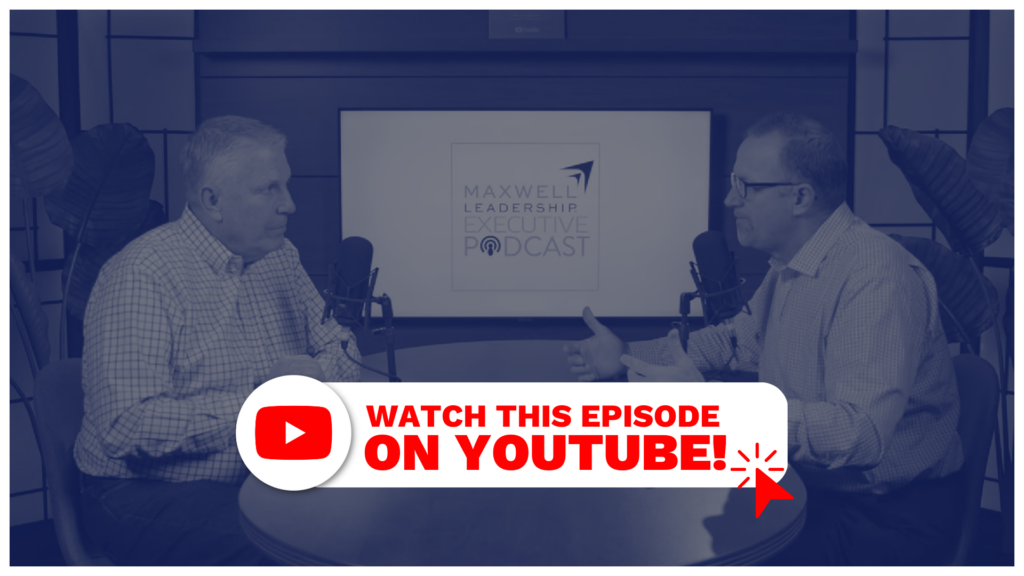Executive Podcast #274: Leading Through Change (Part 1)

In this episode, you’ll discover practical strategies for effective leadership during times of change. Learn how to foster innovation, maintain a strategic mindset, and take decisive action for optimal results. Gain valuable insights into the power of an external perspective, the importance of big picture thinking, and the art of coaching your team to become change agents. Uncover techniques for identifying change resistors, empathetic individuals, and true agents of change, so you can cultivate a team that drives transformation.
This episode is sponsored by Visit Orlando. Whether for business or entertainment, visit Orlando, where the possibilities for business travel are unbelievably real!
References:
Become a Maxwell Leadership Certified Team Member!
Register for Day to Grow on March 9th, 2024!
Download our Learning Guide for this podcast!
Chris Goede:
Hey, listeners, Chris Goede here with some bonus business insight before we jump into today’s episode. If you’re looking for the right place to host your next business gathering, conference or event, look no further than Orlando, Florida. It’s no coincidence that Maxwell leadership hosts our bi annual international Maxwell Conference in Orlando. Between its many luxurious hotels, meeting spaces and venues, Orlando is the perfect place for you and your team to gather, collaborate, and grow. Whether you’re traveling for business or bringing your company for a meeting, there is a reason Orlando is as much a business capital as an entertainment one. And let’s not forget the delicious cuisine at one of the 46 Michelin rated restaurants where your team can kick off your evenings. So before you plan your next business event, check out Orlando, where the possibilities for business travel are unbelievably real.
Perry Holley:
Welcome to the maximum Leadership executive podcast, where our goal is to help you increase your reputation as a leader, increase your ability to influence others, and increase your ability to fully engage your team to deliver remarkable results. Hi, I’m Perry Holly, a Maxwell leadership facilitator and coach.
Chris Goede:
And I’m Chris Goede, executive vice president with Maxwell leadership. Welcome and thank you for joining. We’re going to dive into a two part series, and this is something that at least a two part at least, right? Perry was giving me some directive communication right before we went to record, so we might be changing this up a little bit. But what I love about this is that this came directly from, again, somebody in the field. You dove in, you helped develop some content around it, and we have a new course now that you were behind in leading through change. And so we’re going to break this up into two different parts. What I love about it is it’s very practical. We’ve seen, you and I both, if you’ve done any research and reading on change, you got different diagrams.
Chris Goede:
All of that is great. We want to give you some practical thoughts and approach to leading through change, because there’s lots of challenges that come with that. So before we dive in, though, I want to encourage you to go to maxwellleadership.com/podcast there. If you’ll select this podcast, you’ll go down, you’ll see a form at the bottom. Maybe your organization’s going through some change, maybe as a leader, you’re going through a little bit of change. And if we can help you at all, if you have a thought, if you have a question, fill out that form, let us know and we’ll get back in touch with you. So, Perry, I know this has been something I know last year and last quarter of last year, you’re kind of working through all that. Talk to us a little bit about what stirred you up to bring this to our listeners.
Perry Holley:
Yeah. Well, the client did ask, and we had some things I’d done on change, but it was, like you said, a little more theoretical and how to think about change. I thought when I was talking to Liz, our contact there, she really, our leaders just practically need to know how to lead a change effort. And I thought, you know, that’s a really, I could. One of my specialties for me personally is, how can I simplify this for me? And it really made it easier for the team as well.
Chris Goede:
And it helped you with some podcasts.
Perry Holley:
It helped me with some podcast content. Now I’m pretty pumped about that. One of the starting know, our great leader, John Maxwell, and said, how does John say about change? And really kind of the start of today, I took the quote. I’d seen him say that. He said there are three things that make a successful leader vision, an unwillingness to accept status quo and influence. And I was struck by that, is that we always talk influence a lot. But I think we could almost subtitle. Today’s podcast is developing an unwillingness to accept.
Perry Holley:
To accept status quo.
Chris Goede:
Yeah. Your thoughts, man? Yes, we could have absolutely titled that change is important. I don’t know who to attribute this to. I’ve heard several different sources. But the quote is that if you don’t like change, you’ll like irrelevance a whole lot less. That’s really stuck with me because I will sometimes get into a groove and into a rut and sometimes become complacent. And I’m like, where is that change so that you don’t become irrelevant? We work with one organization. This is interesting dynamic.
Chris Goede:
It’s a challenging dynamic. But I’ll tell you this much. They understand change and innovation, and they live and breathe by this. And they change leadership roles every two years, and you don’t stay in the same role. And so for two years, you go at it, and you’re trying to put your mark on that role, and you see a massive amount of change. But leaders need to understand that you need to be change agents. There is a need for change. And at the end of the day, you talked about this unwillingness to accept status quo.
Chris Goede:
I’ve also heard this said that, man, this is just being so curious that you always want to find a better way to do something. Now, there’s some of that that can become a pain in leaders that feel that way. But one thing’s for sure, you’ll always see a change movement, a change management with those that always think something can get a little bit better.
John Maxwell:
Hey, John Maxwell here. I’m in the studio. We’ve been recording all day, and I was thinking about, really one of my very favorite experiences that we have, and that is called day to grow. If you want to grow, you want to grow in every area of your life. I tell people all the time, you don’t want to go to something. You want to grow to something. But if you’re passionate about personal growth, development your team and growing them, you do not want to miss day to grow. I’m going to have some real players with me, Dion Sanders, Jamie Kern, Lima, myself.
John Maxwell:
You don’t want to miss it. So, market, come and see us on day to grow. I will promise you this. You come and bring your team. At the end of the day, you’ll come up and shake my hand and say, one of the best days I’ve ever invested in for myself and for my team. I’ll see you there.
Perry Holley:
Well, I heard John say, and he was talking to a group and no, he was trying to be funny. I wasn’t sure at first because I took Latin. Everybody else was taking Spanish in high school. I took Latin. And most of the people that know me now say, how’s that working out for you? Not so good. But John said that status quo was latin for the mess we are in. And I thought, I know he’s being funny, but actually it’s funny, but not funny. It really is.
Perry Holley:
If you can get that in your mind, that if you’re okay with status quo, then you’re okay with the mess you’re in. So all leaders need to be change agents. I think if you, again, John was sitting here, said two things leaders need to do. They need to create more leaders and they need to drive change. Because if you’re sitting on status quo, you’re in the mess that you’re in and you’re going to have a problem. Everything else is changing. If you’re not, you’re going to be the problem. So I thought we would talk through maybe just today, briefly, some skill set of becoming that change leader.
Perry Holley:
I did tap some of my research of some guys. I really follow a lot and like what they say, but Dr. Jack Zinger and Dr. Joe Fultman and their research. But they got me thinking about, can you develop the skills set of a change leader? And you absolutely better be seeing yourself as a leader of change, a change agent is usually the phrase that’s used, but I’ll just start and get your feedback on some of that. But one that they said, number one, was that you encourage innovation, that you know, that there is probably a better way to do. Just was. I know, John, you were fortunate to be in the room.
Perry Holley:
I had to listen to recording. This is something I want to speak to you about later. But at the exchange event last year that John was talking about innovation, it requires that we challenge the preconceived beliefs, biases, and assumptions that are around us. That we have to challenge these preconceived beliefs, biases, and assumptions that around us. You were in the room, what you thought about.
Chris Goede:
Yeah. I think that the talk, one that he did on innovation was awesome. And I think that what I learned more from John in that talk and just watching how he goes about change in his life is that there is not something that we don’t look at where he thinks there’s an opportunity in. Like, there are opportunities everywhere. And I think as leaders or even in organizations, I think what we got to be careful of is the growth curves, right? When it begins to hit that plateau, you better have already been thinking about what’s the new opportunity, what’s the new change for the organization before it begins to make the downhill. For those of you that are watching, I’m moving, and those that are listening, you can’t see me moving. But that growth curve, once it starts to plateau, you should already have a change in place to redirect and rechange that growth curve. And it really starts with having a mindset of looking for opportunities inside your business.
Chris Goede:
Don’t get so diversified that you’re not really focused on what your specialty is, but there are definitely opportunities in there. And I think in order for us. I love this. You put this in my notes. I love this. There’s a big difference between being innovative and supporting innovation by others. And we want to, as leaders, be on the innovation side. We want to be, how do we innovate on what we’re doing? How do we look for new opportunities? So that’s what I’d say around encourage innovation.
Chris Goede:
Number two that we have here is move quickly, increase change effectiveness by moving quickly. This right here, when I was going through my notes, I was like, ooh, I could do a much better job at this. We all could, because I think I decide to make a change, but then I kind of drag it on, right? And then I end up getting myself in a little bit of, I’m moving too slow. The team’s not as excited about it. They’re resistant to it. There’s pain versus doing it quickly.
Perry Holley:
You said something ago about the curve and process, how things kind of play out over time, and if you’re not changing, finding the next thing you could be disrupted. So the idea is, can you disrupt yourself? And they call it jumping the curve. I was studying this for this class, but you think of somebody thinking through. Kodak was an example I use. I have a family member that works at Kodak, and I thought, are they still in business? Because they had a chance that they owned the market on something, they could see the change. The curve was starting to decline on film. There’s new technologies on the horizon, and they decided they wanted to protect their film empire and instead somebody else. I think Fuji came in with digital photography and disrupted them and took the market.
Perry Holley:
What was fascinating to me, and I did the looking. The story of Kodak was they already had the technology. They had it from, like, the 70s. They invented digital technology, but they protected that. It’s a very uncomfortable place when you have something that’s working, but you want to go start something new. And this area of discomfort is what keeps us between those two curves. Opens the door for someone else, too. So when you say moving quickly is when I see it, I can’t wait because others aren’t waiting, and so I need to see it.
Perry Holley:
And I love you added that little piece in there about, I don’t have to be the only innovative one here. I can call on the innovation of my team, which says, is the team looking at you to be the change agent, or could you actually coach change agent thinking to your team? They’re on the front lines. What are they seeing? What’s the mess we’re in? Status quo? How can we update change, grow? Is it incremental improvement or is it a whole new thing? Do we have to innovate into some to jump the curve in what we’re doing in our business? So to me, this idea of you better be looking at it and be moving quickly, even if it disrupts you, because somebody else is doing it, and they’ll come and get you, and it’s.
Chris Goede:
Getting faster and faster.
Perry Holley:
Oh, it’s unbelievable.
Chris Goede:
Yeah.
Perry Holley:
Number three, maintaining a strategic perspective as a change agent, that all change that you’re looking at needs to tie back to organizational strategy. You can’t be changing for the sake of changing. Hey, here’s something we could do. And just making stuff up, is that. Is it bringing us closer to what we’re trying to accomplish, what the organization is trying to accomplish, and that we can get caught up in all the change. We forget why we’re doing it. And I’m going to tell you in the class, what we’re finding is part of the model that I put into this class was getting kind of selling change to the team. And if you don’t have a why about why we’re doing the change, we’re just doing it because we think we need the change.
Perry Holley:
No, it’s because it ties to our organizational strategic imperatives, our organizational strategy, and if they believe that, much more likely to buy into what you’re doing. But it’s like, why are we changing? Everything’s just fine. And we’ve got some clients we’ve had this past year that said, hey, life is good. We’re making money, moving great. And now they’re finding themselves, oops, it changed. And we didn’t.
Chris Goede:
Yeah, I think I love what you said about the why. Remember, people receive communication in either the why or the how language. And as you communicate this change, you need to be able to communicate it both to the why and the how. You may not know all of the how as you go through that, but, man, you better, to Perry’s point, you better understand and know the why and relate that to the people as you’re rolling this out. Well, number four, I love this one external perspective, big picture thinking that accounts for how the world is changing. That’s why just when I said just a minute ago, man, it’s getting faster and faster, right? I mean, technology, everything that’s going on in the world is moving faster and faster. And so what are the trends? What is happening in your market? What’s happening in your industry? And then how does that affect, one of the things I was thinking about is, how does that then affect the customer journey that your customer has inside your organization? And you need to be able to adjust there as well. And so what is going on? How do you make those adjustments? But you don’t know that unless you begin to focus a little bit on the outside at times and have that external perspective versus just having the internal perspective of what you’re doing inside the organization.
Perry Holley:
I think about, you mentioned it earlier about even this content. We’re listening, trying to keep an eye on the perspective. What are our customers dealing with? What are they struggling with? How can we change? We could just stay with our cooking and just do what we do. But no, we’re changing to meet demands of the market and demands of our clients. And we got to be thinking all the time out in front about what’s next and where does it go. Number five was what Jack Zinger and Joe Fultman called the balancing the push and pull and the push, the deadlines and the timelines and all the hard part of leading a change effort, making sure that the deliverables are put in and really leading the team and moving people toward completion of the project. The pull is more the inspiration and the motivation, the encouragement, the driving up, the energy of the team, keeping an eye on why we’re moving forward, people remaining inspired about what we’re trying to accomplish. You get into the dog days of a change effort, and people begin to pull back, maybe get tired, maybe lose energy.
Perry Holley:
And so the push got to have all those deliverables, the pull you need to never stop as a change agent, being the inspiring, motivating leader that drives up energy around why we’re doing it and what we can expect to come out of us doing this effort.
Chris Goede:
You have to, as leaders, buy into the change, okay? Because if you don’t, your team’s going to know it right away. Right. And they’re just going to kind of go along with it as excited as you get about it. And so I love you. Talk about creating the energy and the inspiration around that. As we wrap up, I want to share a thought that our CEO, Mark Cole, shared in a leadership meeting with us around change. That kind of ties into exactly what Perry has brought us here, by the way. This is just a sneak peek of an entire course that Perry’s created around change.
Chris Goede:
And if you’re interested in that, you can go to maxwellleadership.com slash podcast. Go to this lesson, click on the lesson, and there’s a form there. Let us know. We would love to help you and your team with it. But as we are working through some change here at Maxwell leadership, Mark Cole, our CEO, said, hey, there’s really three types of people that help with change. And I think it goes in line with this first part of what we’re talking about here. He said, you have your change resistors, which they’re just, you know, not do that, by the way. You’re going to have those on your team.
Chris Goede:
You may be that at times as well. We’re going to have our change empathizers. These are dangerous because they’re like, oh, yeah, I’m with you. I don’t know why they’re making that. You’re empathizing with other people that don’t agree with the change and that could be dangerous. But then you have, and we’ve used this a couple of times just in this session, the change agents. And we want a team of change agents. And in order to do that, what Perry’s brought to us in these five points right here really will kind of lead you to be able to lead people to become change agents.
Perry Holley:
One of the lessons in the class is can you coach change agent thinking to your team? So it’s another nice follow up. Maybe we’ll do that in another episode for sure. Well, thanks for the insights, Chris, and thank you all. Like Chris said, if you want to learn more about our offerings, learn about our other in our podcast family. If you want to leave a comment or a question, you can do all that at maxwellleadership.com/podcast we love hearing from you. Very grateful you’d spend this time with us. That’s all today from the Maxwell Leadership executive podcast.
To be a Successful Leader, You Need Feedback on Your Leadership.
We’re excited to announce our new and improved Organizational Effectiveness Survey (OES). The OES gathers feedback from employees to give leaders and management the knowledge and action plans needed to develop a more effective and productive work environment. Our new version measures 4 areas of your business: Leadership, People, Strategy, and Performance.














Be the first to comment on "Executive Podcast #274: Leading Through Change (Part 1)"